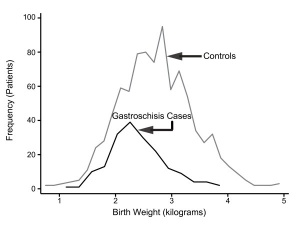Birth-Weight: Difference between revisions
| Line 74: | Line 74: | ||
==Small for Gestational Age== | ==Small for Gestational Age== | ||
[[File:Gastroschisis birth weight graph.jpg|thumb|300px|Gastroschisis Birth Weight Graph]] | |||
There are a large number of known relationships between low birth weight and both maternal and fatal abnormalities, a few examples are shown below. | There are a large number of known relationships between low birth weight and both maternal and fatal abnormalities, a few examples are shown below. | ||
===Fetal Gastroschisis=== | ===Fetal Gastroschisis=== | ||
Gastroschisis patients are commonly small for gestational age (SGA, birth weight < 10th centile). Frequency line graphs of the birth weight distribution.<ref><pubmed>22004141</pubmed>| [http://www.biomedcentral.com/1471-2431/11/90 BMC Pediatr.]</ref> | Gastroschisis patients are commonly small for gestational age (SGA, birth weight < 10th centile). Frequency line graphs of the birth weight distribution.<ref><pubmed>22004141</pubmed>| [http://www.biomedcentral.com/1471-2431/11/90 BMC Pediatr.]</ref> | ||
Revision as of 13:55, 23 May 2012
Introduction
There are a variety of prenatal techniques for estimating approximate birth weight that are relevant for preterm, term and prolonged pregnancy. Ultrasound two- and three-dimensional scanning methods are the basis of most current techniques. There are also standard autopsy weight curves that have been developed from second and third trimester fetal and also neonatal autopsy.
At birth, infants are generally weighed as soon as possible and may also be monitored during the neonatal period.
- Links: Ultrasound | Fetal Origins Hypothesis | Maternal Diabetes | Macrosomia
Birth Weight Classifications
The primary causes of VLBW are premature birth (born <37 weeks gestation, and often <30 weeks) and intrauterine growth restriction (IUGR), usually due to problems with placenta, maternal health, or to birth defects. Many VLBW babies with IUGR are preterm and thus are both physically small and physiologically immature.
| no colour | |||||||||||
| Birth weight (grams) | less 500 | 500 – 999 | 1,000 – 1,499 | 1,500 – 1,999 | 2,000 – 2,499 | 2,500 – 2,999 | 3,000 – 3,499 | 3,500 – 3,999 | 4,000 – 4,499 | 4,500 – 4,999 | 5,000 or more |
| Classification | |||||||||||
Extremely Low Birth Weight
- Less than 500 grams (1 lb 1 oz or less)
- 500 – 999 grams (1 lb 2 oz – 2 lb 3 oz)
Very Low Birth Weight
- 1,000 – 1,499 grams (2 lb 4 oz – 3 lb 4 oz)
Low Birth Weight
- 1,500–1,999 grams (3 lb 5 oz – 4 lb 6 oz)
- 2,000–2,499 grams (4 lb 7 oz – 5 lb 8 oz)
Normal Birth Weight
- 2,500–2,999 grams (5 lb 9 oz – 6 lb 9 oz)
- 3,000–3,499 grams (6 lb 10 oz – 7 lb 11 oz)
- 3,500–3,999 grams (7 lb 12 oz – 8 lb 13 oz)
High Birth Weight
- 4,000–4,499 grams (8 lb 14 oz – 9 lb 14 oz)
- 4,500–4,999 grams (9 lb 15 oz – 11 lb 0 oz)
- 5,000 grams or more (11 lb 1 oz or more)
- see also * macrosomia
No Background Version
| Birth weight (grams) | less 500 | 500 – 999 | 1,000 – 1,499 | 1,500 – 1,999 | 2,000 – 2,499 | 2,500 – 2,999 | 3,000 – 3,499 | 3,500 – 3,999 | 4,000 – 4,499 | 4,500 – 4,999 | 5,000 or more |
| Classification | |||||||||||
Small for Gestational Age
There are a large number of known relationships between low birth weight and both maternal and fatal abnormalities, a few examples are shown below.
Fetal Gastroschisis
Gastroschisis patients are commonly small for gestational age (SGA, birth weight < 10th centile). Frequency line graphs of the birth weight distribution.[1]
- black line - gastroschisis cases
- gray line - controls
The abnormality is usually situated to the right of the umbilicus and abdominal contents, mainly gastrointestinal, are found outside the anterior body wall. Can occur in isolation and also in association with other gastrointestinal anomalies (intestinal atresia, perforation, necrosis or volvulus). Defects in other organ systems have been reported in up to 35% of children.
Maternal Elevated Testosterone
Maternal elevated testosterone levels is associated with low birth weight in humans. Hyperandrogenism associated with polycystic ovarian syndrome (PCOS) and pre-eclampsia have a higher prevalence of small-for-gestational age newborns.
References
- ↑ <pubmed>22004141</pubmed>| BMC Pediatr.
Glossary Links
- Glossary: A | B | C | D | E | F | G | H | I | J | K | L | M | N | O | P | Q | R | S | T | U | V | W | X | Y | Z | Numbers | Symbols | Term Link
Cite this page: Hill, M.A. (2024, April 16) Embryology Birth-Weight. Retrieved from https://embryology.med.unsw.edu.au/embryology/index.php/Birth-Weight
- © Dr Mark Hill 2024, UNSW Embryology ISBN: 978 0 7334 2609 4 - UNSW CRICOS Provider Code No. 00098G
